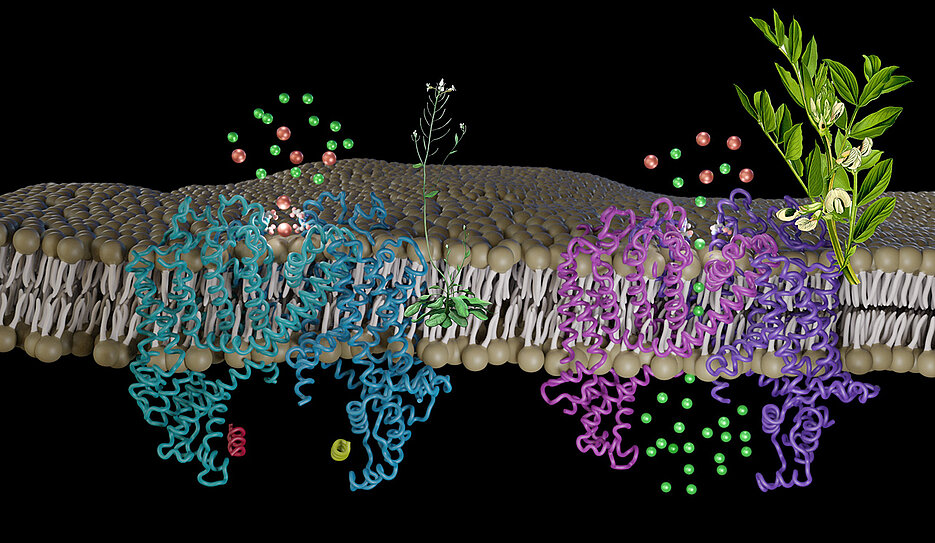Broad Bean Thrives Despite a Hyperactive Ion Channel
11/24/2023Plants in which an ion channel of the vacuole is hyperactive are extremely stressed and grow poorly. But the broad bean is an exception, as Würzburg researchers have discovered.

Like the human body, plants also use electrical signals to process and pass on information. In addition to the cell membrane, the membrane of the central vacuole plays an important role in this process. Vacuoles are typical for plant cells. They are fluid-filled bladders that act as a reservoir for minerals and waste products and can take up to 90 per cent of the cell volume.
Plants also store calcium ions in this reservoir. These in turn keep the electrical switching centre of the vacuole in check, the voltage-dependent ion channel TPC1. Professor Rainer Hedrich, Head of the Chair of Molecular Plant Physiology and Biophysics at Julius-Maximilians-Universität (JMU) Würzburg, discovered this ion channel in 1987 using the patch-clamp technique during his postdoctoral period with Nobel Prize winner Erwin Neher.
Blocking the Channel by Binding Calcium
Years of intensive research have shown that plants carrying a hyperactive mutant of the ion channel are highly stressed and therefore grow less well. It is therefore vital for plants to regulate the activity of the channel properly. The thale cress (Arabidopsis thaliana), the model plant of genetics, covers the channel activity with vacuolar calcium ions: These bind to the channel and thus make it more difficult to open.
Over the past decade, JMU plant researchers have made a significant contribution to the molecular decoding of the calcium binding sites of the Arabidopsis TPC1 channel. In their latest publication in the journal eLife, they now address the question of whether there are plant species-specific variations in the TPC1 gene and how these changes affect the functioning of the channel and thus the electrical excitability of the vacuole.
Broad Bean has a Hyperactive Channel Variant
"Thanks to global sequencing programmes, we have insight into the genomes of an increasing number of wild and cultivated plants," says JMU professor Irene Marten. "For the first time, we were able to identify species-specific deviations in the calcium binding site of the TPC1 channel."
In the search for variants, representatives of the legume family, for example the agriculturally utilised broad bean (Vicia faba), aroused the greatest interest. In patch-clamp studies, Dr Jinping Lu, the first author of the eLife study, proved that the TPC1 channel is much more active and therefore more open in the broad bean than in the thale cress. The hyperactivity of the broad bean channel in turn triggers electrical hyper-excitability in the vacuoles.
"In order to track down the molecular cause of the hyperactivity syndrome, we transplanted areas from the pore of the broad bean channel into the Arabidopsis channel," says Irene Marten, explaining the experimental approach. This idea was successful; the Arabidopsis/broad bean channel chimera was similarly hyperactive as the donor channel from the broad bean. "This allowed us to attribute the hyperactivity of the broad bean channel to the insensitivity of the pore to inhibitory calcium ions," says Rainer Hedrich.
Structural Biologists Found the Reason for Hyperactivity
To understand the exact mechanism, the Würzburg team once again sought the proven collaboration with structural biologists Professor Robert M. Stroud and Dr Sasha Dickinson from the University of California San Francisco (UCSF). The expert duo immediately created a 3D model of the broad bean channel and compared it with the previously determined structure of the Arabidopsis channel.
It turned out that in the broad bean, amino acid residues in the vacuolar entrance area of the channel pore are folded away from the ion transport pathway. As a result, the calcium ions can no longer bind and suppress the channel opening. However, this has no influence on which cations the TPC1 channel allows through, as JMU researchers Dr Ulrich Terpitz and Dr Sabine Panzer from the Chair of Biotechnology and Biophysics have shown.
The Broad Bean’s Canal: Hyperactive but Stress-free
Although the broad bean TPC1 channel is open for longer, the broad beans are not stressed and grow normally. "What mechanisms does the broad bean use to reduce TPC1 channel activity to a tolerable level and thus avoid damage? Or does the broad bean even benefit from the more easily activated TPC1 channel, which is insensitive to calcium, and can therefore adapt better to certain environmental conditions?" With these questions, Irene Marten outlines the team's next research steps.
Publication
Vicia faba SV channel VfTPC1 is a hyperexcitable variant of plant vacuole Two Pore Channels. eLife, 22 November 2023, https://elifesciences.org/articles/86384
Contact
Prof. Dr Irene Marten, Chair of Molecular Plant Physiology and Biophysics, University of Würzburg, irene.marten@uni-wuerzburg.de









